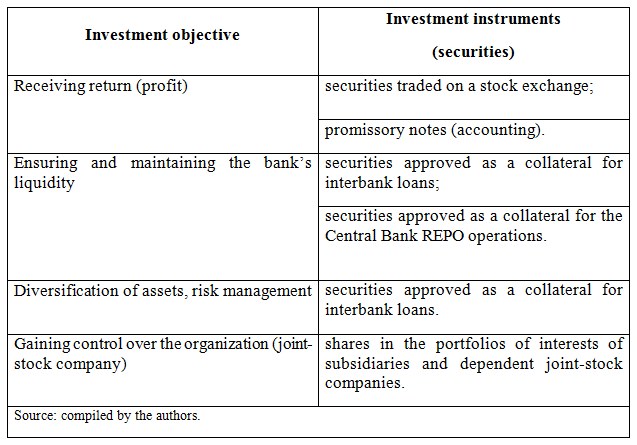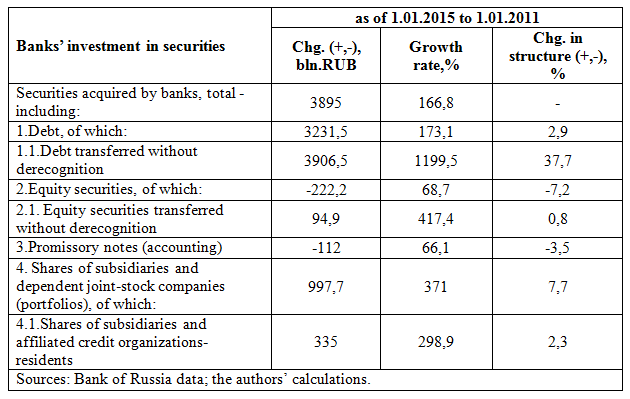ДЕНЕЖНО-КРЕДИТНОЕ РЕГУЛИРОВАНИЕ И ИНВЕСТИЦИИ БАНКОВ В ЦЕННЫЕ БУМАГИ
Юманова Н.Н.1, Ильницкая Т.О.2
1Доцент, кандидат экономических наук, 2старший преподаватель
Тюменский государственный университет
ДЕНЕЖНО-КРЕДИТНОЕ РЕГУЛИРОВАНИЕ И ИНВЕСТИЦИИ БАНКОВ В ЦЕННЫЕ БУМАГИ
Аннотация
В статье рассмотрено влияние денежно-кредитного регулирования на инвестиции банков в ценные бумаги. На основе анализа фактических данных по вложению коммерческих банков в ценные бумаги за последние пять лет определены текущие цели и инструменты банковских инвестиций, особенности их реализации в условиях проводимой Банком России монетарной политики.
Ключевые слова: денежно-кредитное регулирование, монетарная политика, Банк России, инвестиции банков в ценные бумаги, операции РЕПО, ликвидность.
Yumanova N.N.1, Ilnitskaya T.O.2
1Assistant professor, PhD in Economics, 2 senior lecturer,
Tyumen State University
MONETARY CONTROL AND BANKS’ INVESTMENT IN SECURITIES
Abstract
The article considers the impact of monetary control on banks’ investment in securities. Basing on the analysis of evidence on commercial banks’ investment in securities over the last five years the authors identified current objectives and tools of banking investment, as well as peculiarities of their realization in the context of the monetary policy carried out by the Bank of Russia.
Keywords: monetary control, monetary policy, the Bank of Russia, banks’ investment into securities, REPO operations, liquidity.
There is an ever increasing importance of monetary control in conditions of market economy. Monetary control is a set of specific actions of the central bank aimed at changing the amount of money in circulation, the volume of loans, interest rates and other indicators of monetary circulation and financial markets [4, 11]. Thus, the current model of monetary control suggests that the main role in the system of monetary control belongs to the monetary policy of the Central Bank.
The monetary policy of the Central Bank of the Russian Federation (the Bank of Russia) constitutes an integral part of the state economic policy and is aimed at enhancing well-being of Russian citizens [2]. For the purpose of implementing the monetary policy the Bank of Russia conducts operations and uses a number of instruments including interest rates on the Bank of Russia operations; the Bank of Russia REPO operations; secured loans of the Bank of Russia; Bank of Russia operations on purchase and sale of securities on the open market, and others.
In most cases, the Bank of Russia counterparties in such transactions are the commercial banks. The Bank of Russia monetary policy affects the motivation of the behavior of banks and largely determines the quality characteristics of banking including banks’ investment in securities.
Commercial banks are the key players in the stock market in the economy of the Russian Federation. Banks’ investment in securities is a separate direction of banking investment with a distinct form of an object of investment - securities, which indicates their financial footing. It should be noted that the concept of “ banks’ investment in securities" is not defined by the national legislation of the Russian Federation, however, the Bank of Russia regulations indirectly formalize this notion and, in effect, equate it to "investment in securities" [3].
According to some representatives of the academic community "banking investment is long-term investment of banking resources in high-yield securities; indirect investment in the economy due to which the dispersion of investment and obtaining additional profit are achieved "[4, 34].
By investing money in securities, banks pursue several purposes:
- receiving return (profit) on investment in securities due to interest and dividends
paid on securities, as well as obtaining speculative income in the context of rising market value of securities (speculation with securities);
- ensuring and maintaining the liquidity of the bank through the purchase of high
quality securities approved as a collateral for the central bank loans and REPO operatons;
- diversification of assets, risk management - carried out through the purchase of
blue chips attributed by the Central Bank - the state regulator - to risk-free assets;
- obtaining control over the company-issuer or making a significant impact
on the activities of the issuer - joint-stock company by building a portfolio of interests in subsidiaries and dependent joint-stock companies.
These goals are achieved through the use of various securities as investment
instruments. Table 1 shows the compliance of the investment objectives of the bank-investor and the securities - investment instruments.
Table 1. Objectives and instruments of banks’ investment in securities
It is well-known that in today's economy securities that have passed through the listing procedure at the trade organizer and have been admitted to public trading on a stock exchange are considered to be liquid. However, an undeveloped stock market with declining financial capacity, low capitalization, lack of a broad range of investors and investment resources determines that not all unlisted securities may be liquid, i.e. sold on the stock market at any given point of time at a higher price than the price of purchase. In these circumstances, the real liquidity is attributed to only those securities that provide the attraction of funds from the Central Bank through refinancing operations (the Central Bank loans, direct REPO operations) in which such securities act as a means of providing a commercial bank solvency.
The Central Bank of the Russian Federation (Bank of Russia) conducts direct REPO operations and accommodates loans against a collateral of securities in order to provide liquidity to national credit institutions. Only the securities included in the Lombard list - the list of securities approved as collateral for the Bank of Russia loans - are accepted as collateral. The Lombard List (amendments and additions thereto) are published in the "Bulletin of the Bank of Russia" and (or) on the official website of the Bank of Russia in the Internet information and telecommunications network [2]. When compiling the Lombard list, including or excluding the securities from it the Bank of Russia has a direct impact on the attractiveness of certain securities as objects of investment for banks.
Securities securing debt of commercial banks while obtaining loans from the Bank of Russia in REPO operations are transferred to the counterparty – the Bank of Russia - on a repayable basis. In the modern domestic practice banks’ investment in the securities are classified as investment in "securities transferred to counterparties for transactions made on a repayable basis, which haven’t been derecognized" [1].
The analysis of actual investment of Russian banks in securities will allow us to determine the investment objectives and investment banking trends at the present stage.
Table 2. Dynamics of the RF commercial banks’ investment over 5 years
The dynamics of Russian banks' investments in securities is presented in Table 2. There is a growth of commercial banks’ investments in securities with growth rate accounting for 166.8%. However, the dynamics of banks’ investment in different securities is multidirectional. For five years, as of January 2015 the highest growth rate of 1199.6% is observed on investments of commercial banks in debt transferred without derecognition, i.e. securities used in REPO operations. Debt transferred without derecognition occupies the largest share - 43.8% - in the securities portfolio of commercial banks as of January 1, 2015. A significant amount of bank investment in REPO instruments indicates a high need of national banks for obtaining the Bank of Russia's resources and maintaining their liquidity.
There is a significant growth of investment in equity securities transferred without derecognition; it accounts for more than 400% in five years. These securities are used as collateral for the Bank of Russia loans and in REPO operations. A high proportion of these securities in total investment in equity securities is an indirect evidence of the need to ensure the liquidity of commercial banks through the Bank of Russia loans. Overall, the structural changes in banks' investment in equity securities show a decline in speculative investment orientation in favor of increasing their liquidity.
Banks are rapidly increasing their portfolios of interests in subsidiaries and affiliates, as well as investment in debt, which accounts for an increase of 3.7 times and 1.7 times during the study period respectively. An activation of banks’ investment in the shares of subsidiaries and affiliated credit organizations -residents indicates the formation of banking groups and consolidation of the financial resources of credit institutions. On the other hand banks are clearly losing interest in investing in equity securities and accounting bills.
Describing the banks' investments in securities in the 2010-2014, as a whole, one can conclude that banks making financial investment, primarily aim to ensure their own liquidity. Noteworthy is the fact that much of the investment resources of Russian banks is used to service debt of the Government of the Russian Federation or the federal budget deficit. Banks use debt and equity securities from the Bank of Russia Lombard list for obtaining loans from the Bank of Russia as well as in REPO operations. A commercial appeal of debt and equity securities of Russian issuers is decreasing. Speculation of banks investing in the stock market is reducing, which stands for a reduced profitability of financial banking investment. Banks are building up their participation portfolio increasing financial investment in the capital of subsidiaries and dependent companies. The analysis results obtained in the course of the study suggest that in the current period bank investment in securities has changed its goals and transformed from systemically important assets generating substantial profits into a mechanism ensuring the liquidity which is necessary for banks to carry out other operations and income-generating activities. In general, this indicates a decline in the effectiveness of bank investment in securities. It seems that in the case of maintaining the current course of the monetary policy of the Bank of Russia, this trend will continue to develop for banking investment in the medium term.
References
- Giblova N.M. State control of investment activity of commercial banks in the stock market: incentives and constraints // Banking. - M.: Lawyer, 2015, № 2. - P. 56-63.
- Monetary policy. [Electronic resource]. Official site of the Bank of Russia. – Access: http://www.cbr.ru/DKP/
- The procedure for accounting of investment in securities and securities transactions. Annex 10 to the Regulation of the Bank of Russia on July 16, 2012 N 385-P "On accounting rules at credit institutions located in the territory of the Russian Federation." [Electronic resource] Extract from document.// ConsultantPlus.
- Raizberg B.A., Lozovskiy L.S., Starodubtseva E.B. Modern Dictionary of Economics. - 6th ed., rev. and add. - M.: INFRA-M, 2013. – P. 512
- The structure of credit institutions' investments in securities and derivatives. [Electronic resource]. Official site of the Bank of Russia. - Access: http://www.cbr.ru/statistics/print.aspx?file=bank_system.


